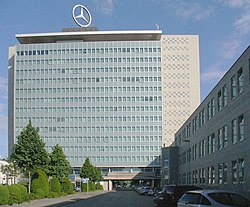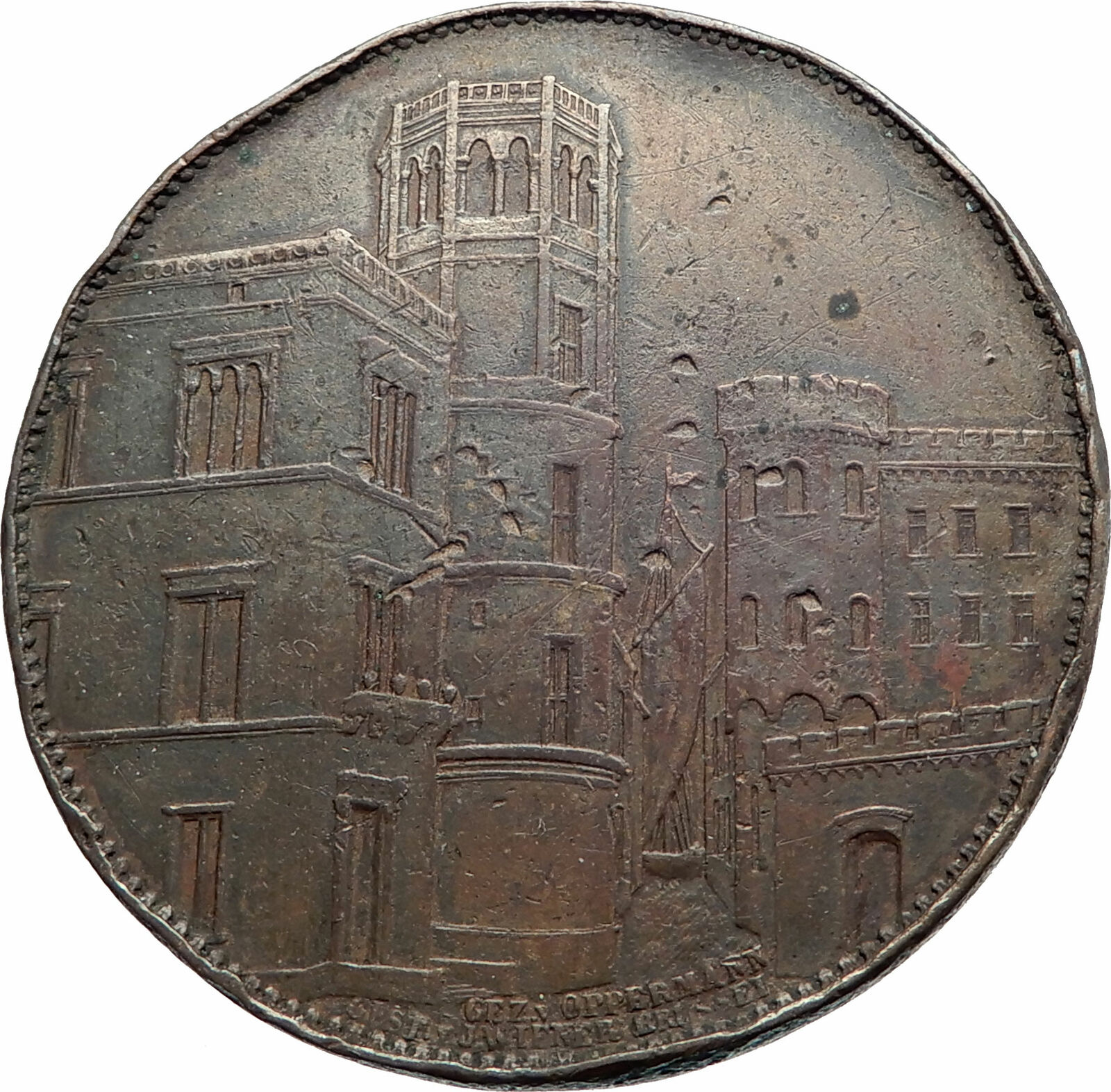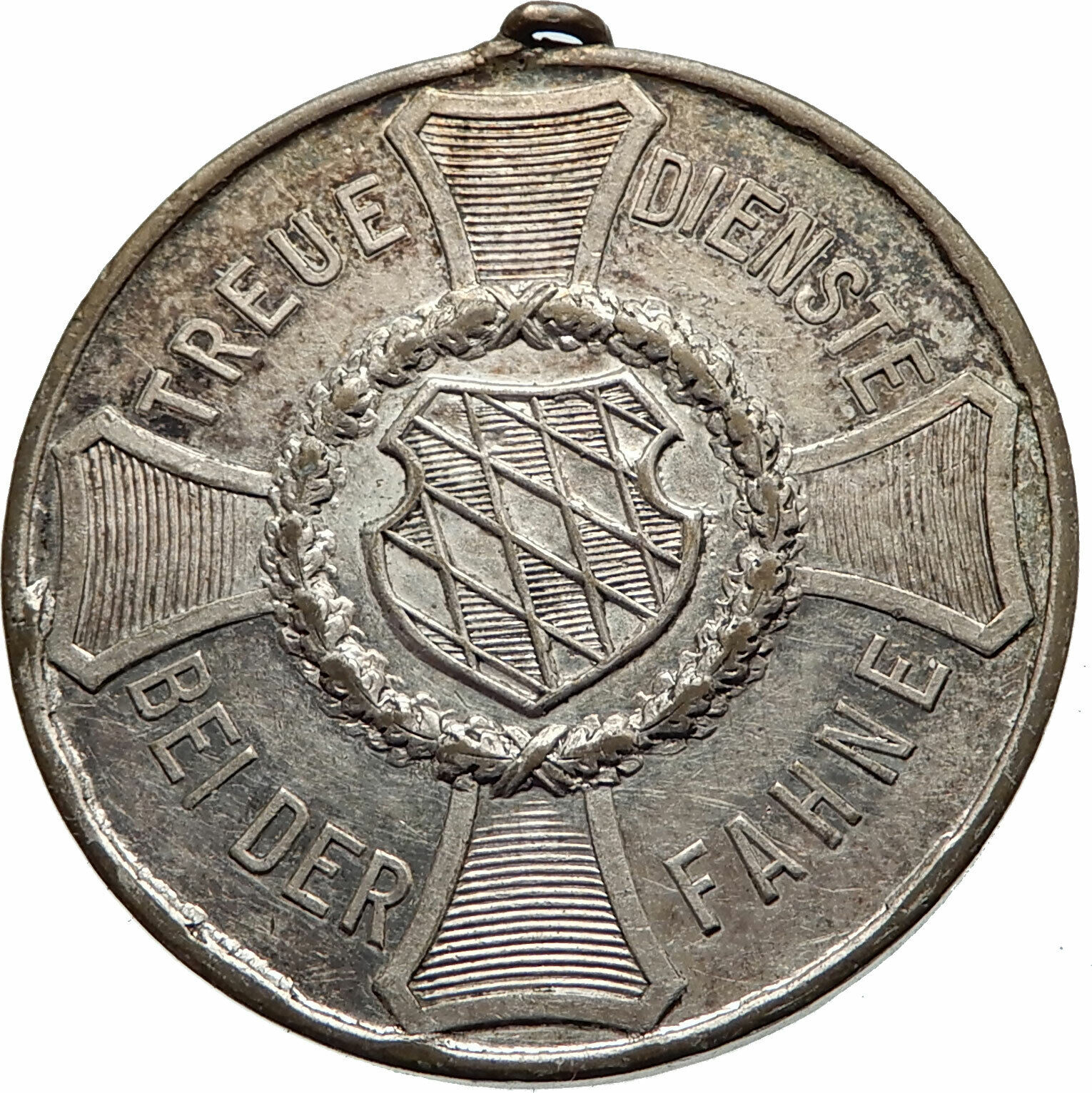|
Germany
1961 Silver Medal 40.3mm (25.05 grams) (0.800 oz. ASW)
DAIMLER BENZ, Heads of Daimler and Benz left.
75 JAHRE MOTORISIERUNG DESVERKEHRS 1886-1961, First motor car left.
You are bidding on the exact item pictured, provided with a Certificate of Authenticity and Lifetime Guarantee of Authenticity.
 Daimler AG’s origin is in an Agreement of Mutual Interest signed on 1 May 1924 between Benz & Cie. (founded 1883 by Karl Benz) and Daimler Motoren Gesellschaft (founded 1890 by Gottlieb Daimler and Wilhelm Maybach). Both companies continued to manufacture their separate automobile and internal combustion engine marques until 28 June 1926, when Benz & Cie. and Daimler-Motoren-Gesellschaft formally merged – becoming Daimler-Benz AG (Aktiengesellschaft) – and agreed that thereafter, all of the factories would use the brand name of “Mercedes-Benz” on their automobiles. The inclusion of the name Mercedes in the new brand name honored the most important model series of DMG automobiles, the Mercedes series, which were designed and built by Wilhelm Maybach. They derived their name from a 1900 engine named after the daughter of Emil Jellinek. Jellinek became one of DMG’s directors in 1900, ordered a small number of motor racing cars built to his specifications by Maybach, stipulated that the engine must be named Daimler-Mercedes, and made the new automobile famous through motorsports. That race car later became known as the Mercedes 35 hp. The first of the series of production models bearing the name Mercedes had been produced by DMG in 1902. Jellinek left the DMG board of directors in 1909. Daimler AG’s origin is in an Agreement of Mutual Interest signed on 1 May 1924 between Benz & Cie. (founded 1883 by Karl Benz) and Daimler Motoren Gesellschaft (founded 1890 by Gottlieb Daimler and Wilhelm Maybach). Both companies continued to manufacture their separate automobile and internal combustion engine marques until 28 June 1926, when Benz & Cie. and Daimler-Motoren-Gesellschaft formally merged – becoming Daimler-Benz AG (Aktiengesellschaft) – and agreed that thereafter, all of the factories would use the brand name of “Mercedes-Benz” on their automobiles. The inclusion of the name Mercedes in the new brand name honored the most important model series of DMG automobiles, the Mercedes series, which were designed and built by Wilhelm Maybach. They derived their name from a 1900 engine named after the daughter of Emil Jellinek. Jellinek became one of DMG’s directors in 1900, ordered a small number of motor racing cars built to his specifications by Maybach, stipulated that the engine must be named Daimler-Mercedes, and made the new automobile famous through motorsports. That race car later became known as the Mercedes 35 hp. The first of the series of production models bearing the name Mercedes had been produced by DMG in 1902. Jellinek left the DMG board of directors in 1909.
The name of Daimler as a marque of automobiles had been sold by DMG – following his death in 1900 – for use by other companies (Daimler Motor Company, Daimler Manufacturing Company, Panhard-Daimler, and Austro-Daimler/Steyr-Daimler-Puch). Since the new company, Daimler-Benz, would have created confusion and legal problems by including Daimler in its new brand name, it therefore used the name Mercedes to represent the Daimler-Motoren-Gesellschaft interest. Karl Benz remained as a member of the board of directors of Daimler-Benz AG until his death in 1929.
Although Daimler-Benz is best known for its Mercedes-Benz automobile brand, during World War II, it also created a notable series of engines for German aircraft, tanks, and submarines. Its cars became the first choice of many Nazi, Fascist Italian, and Japanese officials including Hermann Goring, Adolf Hitler, Benito Mussolini and Hirohito, who most notably used the Mercedes-Benz 770 luxury car. Daimler also produced parts for German arms, most notably barrels for Mauser Kar98k rifles. During World War II, Daimler-Benz employed over 60,000 concentration camp prisoners and other forced laborers to build machinery. After the war, Daimler admitted to its links and coordination with the Nazi government.
In 1966, Maybach-Motorenbau GmbH merged with Mercedes-Benz Motorenbau Friedrichshafen GmbH to form Maybach Mercedes-Benz Motorenbau GmbH, under partial ownership by Daimler-Benz. The company is renamed Motoren und Turbinen-Union Friedrichshafen GmbH (MTU Friedrichshafen) in 1969.
In 1989, Daimler-Benz InterServices AG (Debis) was created to handle data processing, financial and insurance services, and real estate management for the Daimler group.
In 1995, MTU Friedrichshafen became a wholly owned subsidiary of Daimler-Benz.
1998-2007: Daimler Chrysler
In a so-called “Merger of Equals,” or “Marriage made in Heaven”, according to its then CEO and architect Jürgen E. Schrempp, Daimler-Benz AG and United States-based automobile manufacturer Chrysler Corporation, the smallest of the main three American automakers, merged in 1998 in an exchange of shares and formed DaimlerChrysler AG. Valued at US$38 billion, it was the world’s largest ever cross-border deal.
The terms of the merger allowed Daimler-Benz’s non-automotive businesses such as Daimler-Benz InterServices AG, “debis AG” for short, (created in 1989 to handle data processing, financial and insurance services, and real estate management for the Daimler group) to continue to pursue their respective strategies of expansion. debis AG reported revenues of $8.6 bn (DM 15.5 bn) in 1997.
The merger was contentious with investors launching lawsuits over whether the transaction was the ‘merger of equals’ that senior management claimed or actually amounted to a Daimler-Benz takeover of Chrysler. A class action investor lawsuit was settled in August 2003 for US$300 million while a suit by billionaire investor activist Kirk Kerkorian was dismissed on 7 April 2005. The transaction claimed the job of its architect, Chairman Jürgen E. Schrempp, who resigned at the end of 2005 in response to the fall of the company’s share price following the transaction. The merger was also the subject of a book Taken for a Ride: How Daimler-Benz Drove Off With Chrysler, (2000) by Bill Vlasic and Bradley A. Stertz.
Another issue of contention is whether the merger delivered promised synergies and successfully integrated the two businesses. Martin H. Wiggers’ concept of a platform strategy like the VW Group, was implemented only for a few models, so the synergy effects in development and production were too low. As late as 2002, DaimlerChrysler appeared to run two independent product lines. Later that year, the company launched products that appeared to integrate elements from both sides of the company, including the Chrysler Crossfire, which was based on the Mercedes SLK platform and utilized Mercedes’s 3.2 L V6, and the Dodge Sprinter/Freightliner Sprinter, a re-badged Mercedes-Benz Sprinter van.
In 2000, DaimlerChrysler acquired the Detroit Diesel Corporation and placed its on-highway division under Daimler Trucks North America. The off-highway division was placed under MTU Friedrichshafen to form MTU America. Detroit Diesel branding has been maintained by DTNA and MTU America. In 2005, MTU-Friedrichshafen was sold to the Swedish investment firm EQT Partners.
Daimler agreed to sell the Chrysler unit to Cerberus Capital Management in May 2007 for US$6 billion. Through most of its history, Chrysler has been the smallest of the “Big 3” U.S. automakers, but in January 2007, DaimlerChrysler, excluding its luxury Mercedes and Maybach lines, also outsold traditionally second place Ford, though behind General Motors and Toyota.
Chrysler reported losses of US$1.5 billion in 2006. It then announced plans to lay off 13,000 employees in mid-February 2007, close a major assembly plant and reduce production at other plants in order to restore profitability by 2008.
DaimlerChrysler had reportedly approached other carmakers and investment groups to sell Chrysler in early 2007. General Motors was reported to be a suitor, but on 3 August 2007, DaimlerChrysler completed the sale of Chrysler Group to Cerberus Capital Management. The original agreement stated that Cerberus would take an 80.1 percent stake in the new company, Chrysler Holding LLC. DaimlerChrysler changed its name to Daimler AG and retained the remaining 19.9% stake in the separated Chrysler LLC.
The terms saw Daimler pay Cerberus US$650 million to take Chrysler and associated liabilities off its hands. Of the US$7.4 billion purchase price, Cerberus Capital Management was to invest US$5 billion in Chrysler Holdings and US$1.05 billion in Chrysler’s financial unit. The de-merged Daimler AG received US$1.35 billion directly from Cerberus but directly invested US$2 billion in Chrysler itself. Chrysler filed bankruptcy in 2009.
DC Aviation rose in 2007 from the previous DaimlerChrysler Aviation, an auxiliary of DaimlerChrysler AG, which was established in 1998.
2007-present: Daimler AG
In November 2014, Daimler announced it would acquire 25 percent of Italian motorcycle producer MV Agusta for an undisclosed fee. MV Holding acquired the 25 percent of MV Agusta back from Daimler in December 2017.
On 3 August 2015, Nokia announced that it had reached a deal to sell its Here digital maps division to a consortium of three German automakers-BMW, Daimler AG, and Volkswagen Group, for €2.8 billion. This was seen as an indication that the automakers were interested in automated cars.
In 2017, Daimler announced a series of acquisitions and partnerships with car startups focused on car sharing, in a move towards what it sees as the next generation of car ownership and usage. Part of its corporate strategy is to “transition from being an automobile manufacturer to a mobility services provider”.
In April 2017 it announced a partnership with Via, a New York-based ride-sharing app, to launch a new ride-sharing service across Europe. In September, it was announced that Daimler had led a fundraising round for car-sharing start up Turo, which is a platform that lets owners rent their vehicles out to other users. It also acquired Flinc, a German startup that has built an app for peer-to-peer-style carpooling, has invested in Storedot, Careem, Blacklane and FlixBus, and has acquired car2go and mytaxi (now Free Now).
Chinese automobile manufacturer Geely took a 9.69% stake in the company, through a subsidiary, in February 2018, making it the company’s largest single shareholder. In September 2018, Daimler invested $155 million in Electric Bus Maker Proterra.
In July 2019, BAIC Group purchased a 5% stake in Daimler, which is a reciprocal shareholder in BAIC’s Hong Kong listed subsidiary.
In September 2019, Daimler announced that it would be “stopping its internal combustion engine development initiatives as part of its efforts to embrace electric vehicles.”
In February 2020, Daimler partnered with Opus 12 to create the world’s first C-pillar made with polycarbonate from CO2 electrolysis in an effort towards a fully carbon neutral fleet.
  Germany, officially the Federal Republic of Germany is a federal parliamentary republic in western-central Europe. It includes 16 constituent states and covers an area of 357,021 square kilometres (137,847 sq mi) with a largely temperate seasonal climate. Its capital and largest city is Berlin. With 81 million inhabitants, Germany is the most populous member state in the European Union. After the United States, it is the second most popular migration destination in the world. Germany, officially the Federal Republic of Germany is a federal parliamentary republic in western-central Europe. It includes 16 constituent states and covers an area of 357,021 square kilometres (137,847 sq mi) with a largely temperate seasonal climate. Its capital and largest city is Berlin. With 81 million inhabitants, Germany is the most populous member state in the European Union. After the United States, it is the second most popular migration destination in the world.
Various Germanic tribes have occupied northern Germany since classical antiquity. A region named Germania was documented before 100 CE. During the Migration Period the Germanic tribes expanded southward. Beginning in the 10th century, German territories formed a central part of the Holy Roman Empire. During the 16th century, northern German regions became the centre of the Protestant Reformation.
The rise of Pan-Germanism inside the German Confederation resulted in the unification of most of the German states in 1871 into the Prussian-dominated German Empire. After World War I and the German Revolution of 1918-1919, the Empire was replaced by the parliamentary Weimar Republic. The establishment of the Third Reich in 1933 led to World War II and the Holocaust. After 1945, Germany split into two states, East Germany and West Germany. In 1990, the country was reunified.
 In the 21st century, Germany is a great power and has the world’s fourth-largest economy by nominal GDP, as well as the fifth-largest by PPP. As a global leader in several industrial and technological sectors, it is both the world’s third-largest exporter and importer of goods. Germany is a developed country with a very high standard of living sustained by a skilled and productive society. It upholds a social security and universal health care system, environmental protection and a tuition free university education. In the 21st century, Germany is a great power and has the world’s fourth-largest economy by nominal GDP, as well as the fifth-largest by PPP. As a global leader in several industrial and technological sectors, it is both the world’s third-largest exporter and importer of goods. Germany is a developed country with a very high standard of living sustained by a skilled and productive society. It upholds a social security and universal health care system, environmental protection and a tuition free university education.
Germany was a founding member of the European Union in 1993. It is part of the Schengen Area, and became a co-founder of the Eurozone in 1999. Germany is a member of the United Nations, NATO, the G8, the G20, and the OECD. The national military expenditure is the 9th highest in the world. Known for its rich cultural history, Germany has been continuously the home of influential artists, philosophers, musicians, sportsmen, entrepreneurs, scientists and inventors.
|





 Daimler AG’s origin is in an Agreement of Mutual Interest signed on 1 May 1924 between Benz & Cie. (founded 1883 by Karl Benz) and Daimler Motoren Gesellschaft (founded 1890 by Gottlieb Daimler and Wilhelm Maybach). Both companies continued to manufacture their separate automobile and internal combustion engine marques until 28 June 1926, when Benz & Cie. and Daimler-Motoren-Gesellschaft formally merged – becoming Daimler-Benz AG (Aktiengesellschaft) – and agreed that thereafter, all of the factories would use the brand name of “Mercedes-Benz” on their automobiles. The inclusion of the name Mercedes in the new brand name honored the most important model series of DMG automobiles, the Mercedes series, which were designed and built by Wilhelm Maybach. They derived their name from a 1900 engine named after the daughter of Emil Jellinek. Jellinek became one of DMG’s directors in 1900, ordered a small number of motor racing cars built to his specifications by Maybach, stipulated that the engine must be named Daimler-Mercedes, and made the new automobile famous through motorsports. That race car later became known as the Mercedes 35 hp. The first of the series of production models bearing the name Mercedes had been produced by DMG in 1902. Jellinek left the DMG board of directors in 1909.
Daimler AG’s origin is in an Agreement of Mutual Interest signed on 1 May 1924 between Benz & Cie. (founded 1883 by Karl Benz) and Daimler Motoren Gesellschaft (founded 1890 by Gottlieb Daimler and Wilhelm Maybach). Both companies continued to manufacture their separate automobile and internal combustion engine marques until 28 June 1926, when Benz & Cie. and Daimler-Motoren-Gesellschaft formally merged – becoming Daimler-Benz AG (Aktiengesellschaft) – and agreed that thereafter, all of the factories would use the brand name of “Mercedes-Benz” on their automobiles. The inclusion of the name Mercedes in the new brand name honored the most important model series of DMG automobiles, the Mercedes series, which were designed and built by Wilhelm Maybach. They derived their name from a 1900 engine named after the daughter of Emil Jellinek. Jellinek became one of DMG’s directors in 1900, ordered a small number of motor racing cars built to his specifications by Maybach, stipulated that the engine must be named Daimler-Mercedes, and made the new automobile famous through motorsports. That race car later became known as the Mercedes 35 hp. The first of the series of production models bearing the name Mercedes had been produced by DMG in 1902. Jellinek left the DMG board of directors in 1909. 
 Germany, officially the Federal Republic of Germany is a federal parliamentary republic in western-central Europe. It includes 16 constituent states and covers an area of 357,021 square kilometres (137,847 sq mi) with a largely temperate seasonal climate. Its capital and largest city is Berlin. With 81 million inhabitants, Germany is the most populous member state in the European Union. After the United States, it is the second most popular migration destination in the world.
Germany, officially the Federal Republic of Germany is a federal parliamentary republic in western-central Europe. It includes 16 constituent states and covers an area of 357,021 square kilometres (137,847 sq mi) with a largely temperate seasonal climate. Its capital and largest city is Berlin. With 81 million inhabitants, Germany is the most populous member state in the European Union. After the United States, it is the second most popular migration destination in the world. In the 21st century, Germany is a great power and has the world’s fourth-largest economy by nominal GDP, as well as the fifth-largest by PPP. As a global leader in several industrial and technological sectors, it is both the world’s third-largest exporter and importer of goods. Germany is a developed country with a very high standard of living sustained by a skilled and productive society. It upholds a social security and universal health care system, environmental protection and a tuition free university education.
In the 21st century, Germany is a great power and has the world’s fourth-largest economy by nominal GDP, as well as the fifth-largest by PPP. As a global leader in several industrial and technological sectors, it is both the world’s third-largest exporter and importer of goods. Germany is a developed country with a very high standard of living sustained by a skilled and productive society. It upholds a social security and universal health care system, environmental protection and a tuition free university education.




